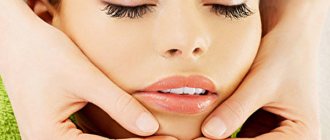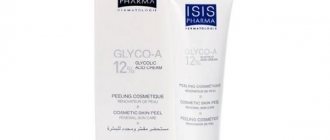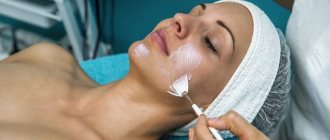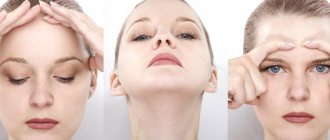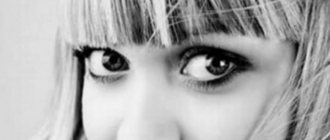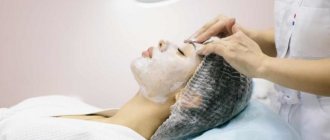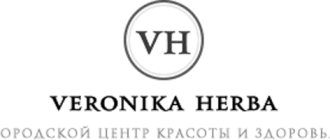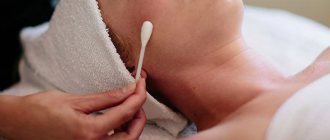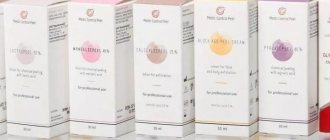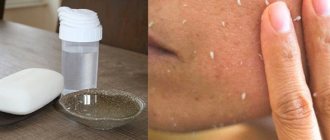Deep cleansing of the skin using retinol (retinoic) or yellow peeling is a popular procedure. The technique allows you to exfoliate the dead, non-functioning layer of epidermal cells, improve tissue health, improve skin functioning, whiten skin, and correct age-related changes. The intervention is performed with the help of retinol (retinoic acid), which gives the skin a characteristic yellowish color, provoking active peeling with subsequent renewal of the surface. Depending on the composition and aggressiveness of the effect, you can perform superficial, medium or deep cleansing. The procedure is carried out by cosmetologists, but light versions of yellow peeling can be performed independently. Russian retinol peeling Arcadia is a universal product that combines the work of a doctor in a responsible part with home restorative care.
Description of peeling
Retinol peeling Carrot's peel from the Russian beauty laboratory "Arcadia" was proposed by the manufacturer in 2011. The option is highly effective, successfully combined with comfort, minimal invasiveness of the procedure, and a soft, predictable post-peeling period.
The substance contains:
- retinol (exfoliation, inhibition of aging, participation in the regulation of sebum secretion, protection against the destruction of collagen fibers, stimulation of the formation of fresh protein components of the skin, antioxidant protection);
- beta-carotene or proretinol (supporting skin firmness, elasticity, preventing aging, protecting against vascular blockage);
- retinol esters (vitamin A accumulation, prolongation of the beneficial effect of exfoliation);
- ascorbic acid or vitamin C (anti-inflammatory, antioxidant, whitening effect, stimulation of regeneration, acceleration of collagen synthesis, improvement of vascular permeability);
- tocopherol acetate or vitamin E (antioxidant, anti-inflammatory, restorative effect, stimulation of proper tissue functioning, absorption of vitamin A, prevention of oxidation);
- Hesperdin (strengthening, protecting capillaries).
Note! The product has an orange color and colors the skin in a characteristic reddish tone, typical of a fresh tan. The tint appears immediately after the procedure and is gradually washed off.
Carrot's peel from Arkady is sold in sets containing:
- peeling gel 10 ml;
- restoring cream 10 ml;
- cream with SPF30 10 ml;
- concentrate with panthenol 2 ampoules of 2 ml.
Consistent use of substances according to the manufacturer’s protocol specified in the instructions for peeling will allow you to obtain the promised result without complications. You can buy Arcadia retinol peeling on the company’s official website, but you will need proof of professionalism. Each Carrot's peel set from Arkady is designed for 2 procedures.
How to make retinol peeling at home (instructions)
Before performing yellow peeling at home, you must refrain from visiting the sauna, bathhouse, solarium, or beach for several days before the procedure. You should also avoid using exfoliating cosmetics and scrubs.
The peeling itself is performed in stages:
- clean the skin of dirt and cosmetics, degrease, dry;
- apply a solution of glycolic and salicylic acids (they will soften the skin, which will allow you to remove dead cells without unnecessary effort);
- rinse off the solution and dry the skin;
- apply 1 to 3 layers of retinol mass, purchased in advance at a pharmacy or specialty store (the number of layers depends on the desired effect and skin condition, as a rule, it is prescribed in the instructions for a specific drug);
- leave for 15 minutes to 10 hours and remove the mass using warm soapy water or a special product (included in some ready-made retinol peeling kits);
- moisturize the skin with protective cream.
The recovery stage after peeling takes several days, during which the skin peels off and new ones form in their place.
There may also be redness and swelling, tightness and dryness of the skin, which disappear over time. Important to remember! You cannot remove flaky pieces by hand to avoid uneven pigmentation! The process should take place naturally. The only way to help it is by applying a moisturizer.
After peeling, the skin must be thoroughly moisturized and protected from ultraviolet radiation. You should give up cosmetics for 7-10 days.
Retinol (yellow) peeling is a modern anti-aging procedure that allows you to successfully fight the first signs of aging, as well as actively counteract existing skin problems. A minimal list of contraindications makes it accessible to most women, regardless of age.
Retinol (yellow) peeling for facial skin rejuvenation and before and after results, see this video:
Indications for use
Arcadia retinol peeling is indicated for any age starting from 18 years. Cosmetologists advise starting anti-aging exfoliation no earlier than 35 years.
There is no dependence on skin type. The procedure will be an excellent preventive or therapeutic measure. Yellow peeling will have a beneficial effect on the appearance and condition of the skin. Cosmetologists recommend a procedure using Arkady retinol peeling for:
- treatment of acne of varying severity (from mild to moderate);
- eliminating post-acne spots, hyperpigmentation;
- preventing photoaging;
- prevention, correction of age-related changes (wrinkles);
- getting rid of hyperkeratosis;
- regulation of impaired sebum secretion;
- deep cleansing of pores (presence of sebaceous plugs, blackheads, comedones);
- slowing down the aging process (loss of firmness, elasticity of the skin, ptosis);
- returning your face to a fresh, healthy look.
The doctor will determine the possibility of solving existing skin problems in a particular case. The cosmetologist will assess the condition of the skin, recommend ways to combat disorders, and develop an individual treatment regimen.
Retinol peeling results: before and after photos
As a result of retinol peeling, renewal and rejuvenation processes are launched in the dermis.
Photos “before and after” of the procedure confirm that problematic skin, which has a wide variety of imperfections, is significantly transformed. It becomes toned, with an even tone and relief, with a healthy structure.
Wrinkles are reduced or completely disappeared, and a healthy glow appears on the face. Thanks to the bactericidal and comedolytic effect of the composition, the skin is cleansed and healed.
Of course, the result of peeling depends on the woman’s age, the condition of her skin and the number of sessions. That is why it is recommended to undergo retinol peeling in a beauty salon or clinic, under the supervision of a professional cosmetologist or dermatologist.
Correctly selected active composition, duration and number of procedures will allow you to get as close as possible to the desired effect.
Note! The result of yellow peeling does not appear immediately, but several days later, after the period of peeling of the skin ends.
Efficiency of application
Arcadia retinol peeling is recognized as a fast, effective way to improve skin quality. The procedure is characterized by maximum comfort during the intervention period, in comparison with other options for the yellow type of exfoliation, and is characterized by a minimum amount of inconvenience during recovery.
To achieve optimal results, 2 sessions of retinol exfoliation are sufficient. In difficult cases (problematic, aging skin), a cosmetologist may prescribe a more intensive course of procedures. Positive changes are noticeable after the first intervention:
- the face becomes fresher and takes on a healthy appearance;
- freckles and age spots lighten;
- pores are cleansed, the number of rashes is reduced;
- the number of wrinkles is reduced, deep creases become less noticeable;
- scars and stretch marks are smoothed out;
- Pores are reduced, the problem of excessive oiliness and dry skin disappears;
- tissues reach optimal tone, sagging becomes less noticeable, and a slight lifting effect is visible.
Retinol exfoliation procedures are carried out 1–2 weeks apart. It is recommended to perform the intervention on the eve of the weekend (preferably on Wednesday, Thursday), providing the skin with the opportunity for a calm recovery. Before the Arkady retinol peeling course, as well as in anticipation of any other yellow exfoliation option, preparation of the integument is necessary. The process will take 2–4 weeks.
Retinol peeling: reviews from cosmetologists and dermatologists
Cosmetologists and dermatologists recommend using peeling as a rejuvenating and caring procedure due to a number of advantages that it has in comparison with other cosmetic procedures.
The main one is naturalness. Peeling substances, absorbed into the skin, are converted into retinoic acid, which is natural for the body, which, having accumulated in the skin in a certain amount, starts the renewal process - the skin begins to peel and flake off, and a new layer is formed.
Thanks to natural processes, unpleasant consequences such as chemical burns are eliminated. For the same reason, retinol peeling can be used by women and girls with fair skin, clients suffering from rosacea, as well as those with dark skin who want to lighten it.
The process of exfoliation of the top layer of skin and regeneration of renewed cells - due to which the skin whitens and smoothes
The second advantage of retinol peeling, which can be identified from reviews of cosmetologists and dermatologists, is a long-term effect not only on the superficial, but also on the middle layers of the dermis.
The processes triggered by retinol improve the condition of the skin from the inside, stimulating the synthesis of elastin and collagen. Cellular metabolism is activated, thanks to better blood supply, the skin receives more nutrients and moisture, the skin looks fresher and healthier.
Interesting fact! Retinol peeling is recommended to be carried out in a course of 3 procedures with an interval of approximately 1.5–2 weeks.
Once you decide on the procedure, you should consult a dermatologist, as some contraindications still exist.
These include:
- the period of pregnancy and breastfeeding (also you should not do it if you are planning a pregnancy in the next six months or a year);
- allergy to aspirin;
- skin allergic reactions;
- diseases of the cardiovascular system, liver, kidneys or lungs;
- skin diseases - eczema, dermatitis, etc.;
- viral infections;
- warts, rosacea, papillomas in the affected area;
- photosensitivity of the skin or period after radiation therapy;
- intolerance to the components of the drug;
- treatment with vitamin A or taking retinoids.
Professional and home treatment options
It is permissible to carry out yellow peeling yourself. To do this, you need to carefully study the rules for performing the intervention, stock up on the necessary materials, and strictly follow the manufacturer’s instructions.
To prevent complications and complaints, many manufacturers limit the free sale of chemical peels. You will have to make the composition yourself or choose an option from those available for sale.
A professional cosmetologist will perform the procedure in strict accordance with the protocol. Doctors must be trained to work with the substance used. The cosmetologist will assess the condition of the skin, select the correct scheme for applying the composition, and calculate the details of the course. The only inconvenience of professional performance: the duration of the session. It is recommended to discuss all the nuances and possible options with your doctor in advance.
How to Apply Retinoic Yellow Peel
The procedure begins with the doctor placing the contents of the tube (a mask with a 5-10% concentration of retinoic acid) into a bowl. Next, he evenly covers the patient's face with the mixed mass. No area should be skipped, even the lower and upper areas of the eyelids (along the eyelash edge). The only things that are not peeled are eyelashes and eyebrows. After about 10-25 minutes, the mask will harden on the face in the form of a film. After the required amount of time, which was agreed upon in consultation with a doctor, the mass is removed, the face is thoroughly washed, and then a special sunscreen substance is applied.
In most cases, a retino yellow peel course consists of four procedures. The order of their implementation is as follows: two weeks should pass after the first session, one month after the second and all subsequent ones. Thus, the course lasts two and a half months from the moment of the first peeling. And in total it turns out to be three months, if you take into account the two-week preparatory period. After completing the course, this type of peeling can be repeated every three months to maintain skin condition.
Read material on the topic: Plasmolifting of the face - a breakthrough in domestic cosmetology
Preparing for the session
A preliminary visit to a cosmetologist will be a prerequisite for a successful preparatory stage. The doctor will collect an anamnesis, prescribe additional tests if necessary, perform an allergy test, assess the condition of the integument, and indicate a list of measures that must be performed. Typically the list includes:
- refusal to tan (for fair-skinned people up to 2 weeks, for dark-skinned people up to 4 weeks);
- using products with fruit acids in home care, conducting 1–2 sessions of mild peeling (the glycolic version is often used), including cosmetics with a low content of retinoids;
- preliminary mesotherapy (biorevitalization) for excessive dryness and flabbiness of the integument;
- preventive treatment for a high tendency to herpes and other diseases with a high probability of exacerbation after exfoliation.
Retinol exfoliation is not done during pregnancy, at the stage of planning conception. This must be taken into account when preparing for the course. The intervention is also not carried out on damaged, irritated skin. Before the session, it is recommended to protect the skin from microtraumas.
important! Retinol peeling Arcadia is preferably carried out in the autumn-winter period. This will simplify the recovery task. When performing the intervention in the summer, you will have to use cosmetics with increased ultraviolet protection and avoid being in the sun.
During the preparation period, it is important to avoid systemic retinoids, vitamin A, and surface application of high concentration substances.
Yellow exfoliation and pregnancy
During pregnancy, yellow peeling is undesirable for several reasons.
Risks to fetal development
Despite the lack of evidence on the tetragenic nature of retinol and its synthesized analogues, as well as on the systemic effect of the drug and its accumulation in the blood plasma, it is better for pregnant women to refuse yellow exfoliation sessions. Especially in the second or third trimester of pregnancy. In the early stages, the contact between the mother and the embryo has not yet been formed, because the common vascular network is just beginning to form. In any case, you need to warn the cosmetologist in advance that you are expecting a baby.
Mom's allergies
The body of a pregnant woman may respond with an allergic reaction to the components of the retinoic peel. Therefore, if you nevertheless decide in favor of such exfoliation, while you are pregnant, ask your cosmetologist to conduct an allergy test before the peeling session. To do this, apply a drop of the product to the thin skin of the wrist, the inner bend of the elbow or behind the ear. An atypical reaction will appear within 10-15 minutes. If itching or redness does not appear, the peeling preparation will not cause allergies.
Possibility of side effects
During pregnancy, the peeling procedure can go wrong. Firstly, because the expectant mother’s body is sensitive to external influences and unfamiliar odors. Secondly, because pregnancy is a time of hormonal changes in the female body. Changing hormone levels may cause unexpected pigmentation, pimples, or redness to appear after a peel.
The decision to perform yellow peeling on the eve of or during pregnancy is made by each woman independently. Of course, most cosmetologists will not undertake a retinoic procedure knowing that the client is pregnant. But some young ladies in the weather prefer to keep silent about it for beauty reasons. Considering specialists’ doubts about the “harmlessness” of retinol and its safety for the normal formation of the fetus, it is still better to warn the specialist about the planned conception or pregnancy before the exfoliation session.
Progress of the procedure
The Arcadia retinol peeling process is clearly regulated, but the cosmetologist performing the session can vary the time frame depending on the condition of the patient’s skin. This is the main danger of performing such procedures independently. Not everyone will be able to “guess” the required parameters.
Before the procedure, the cosmetologist performs a visual inspection of the skin. After thorough superficial cleansing, the skin assessment is complemented by examination using a special lamp and magnifying glass. If viral warts, active herpes, or molluscum contagiosum are detected, the procedure is not performed.
Apply to clean skin using a special Carrot's peel brush. Affects the base surface, neck and décolleté. The substance is also applied to the eyelids, retreating 2-3 mm from the eyelash edge. Peeling is not applied to the eyebrows; they are removed from the hairline.
The treated surface is covered with film. The patient is left in this state for 15–60 minutes (determined individually by the cosmetologist). During the period of intense exposure, no serious discomfort occurs. A slight tingling sensation and mild hyperemia may occur. After the selected period, excess product is removed from the surface with a napkin. The skin is not rinsed with water or smeared with anything additional.
The cosmetologist stipulates the rules of skin care and behavior during the recovery period. The components of the Carrot's peel kit, intended for home use, are given to the patient. The client goes home with a “beautiful” yellowish mask on his face.
It is no secret that the skin, and especially the skin of exposed surfaces (face, neck, décolleté, hands) plays a significant role in shaping the aesthetic appeal of a person’s image. Unfortunately, like other organs, the skin undergoes age-related changes, which can create certain problems and complexes in people; Moreover, the share of the subjective factor in this issue seems to be very high. Involutional changes in the skin are caused by a decrease in the mitotic activity of epidermal and dermal cells, thinning of the Malpighian layer, hyperkeratosis, smoothing of the dermoepidermal border, a decrease in the number of full-fledged type I collagen fibers, elastic fibers, and glycosaminoglycans. Skin aging is characterized by changes in its density, elasticity, ptosis and the formation of wrinkles; in this case, the skin has a covering function, but does not support the rest of the facial tissues. This circumstance seems important from the standpoint of the correct choice of methods for correcting age-related changes in the face, since in addition to the skin, the involution process involves fatty, muscle and bone tissue, and therefore not all costs of age can be corrected by influencing only the skin.
Often, professional and/or personal motives to smooth out the influence of time lead a person to specialists in the field of plastic surgery and aesthetic cosmetology. Currently, to solve this problem, peeling has become widespread as an effective procedure that can eliminate a number of skin defects, as well as promote its “rejuvenation.”
Peeling
(from the English to peel, to peel off - peel off, exfoliate, exfoliate)
is the controlled removal of a certain number of layers of the epidermis and dermis along with existing defects to initiate the restoration of all destroyed layers. Thus, the physiological basis of peeling is stimulation of regeneration.
The doctrine of regeneration is one of the key branches of biology and medicine. Regeneration or revival is the property of organisms to re-form their organs and tissues that have been lost as a result of various reasons. Since the end of the 19th century. There is a division of regeneration into physiological and reparative, however, at present the border between these two types does not seem sharp. Reparative regeneration is based on physiological, the mechanisms for implementing the process are largely identical, and the differences are predominantly quantitative.
A cosmetologist, inflicting damage to the patient’s skin during salon peeling, stimulates reparative processes in it, the degree of manifestation of which depends on the nature and area of the injury. Thus, we can say that the basis of the corrective and “rejuvenating” effects of peeling is reparative (regenerative) morphogenesis.
The healing process can be considered as a complex sequence of interactions between cells, mediators, and components of the intercellular matrix, in the implementation of which a significant role (integration and operational communication) belongs to signaling protein molecules—cytokines.
Indications for peeling include seborrhea, acne and post-acne skin changes, scars, hyperpigmentation, actinic dermatitis, keratosis, hyperkeratosis, age-related skin changes (wrinkles, small folds, decreased turgor), etc. From the perspective of the doctrine of regeneration in elderly and senile people , which is characterized by thinning and atrophy of the skin, it does not seem advisable to prescribe peeling.
Based on the method of exposure, the following main types of peeling are distinguished:
- Mechanical
- superficial, medium (microdermabrasion) and deep (standard dermabrasion). This group includes gommage (peeling without abrasive particles by applying a special mixture to the skin, gluing it to the surface layer of the epidermis, followed by “rolling off” dead horny scales from the facial skin - similar to the action of a pencil eraser), peeling scrub (using abrasive particles) , brossage (hardware or brush peeling). - Chemical
- superficial (fruit acids), middle (salicylic and trichloroacetic acids), deep (phenol). - Physical
- superficial (ultrasound, erbium laser), medium (erbium laser with a penetration depth of 30 microns), deep (carbon dioxide laser with a penetration depth of 80-150 microns).
It should be noted that any type of deep peeling is an aggressive procedure for the skin.
The earliest mentions of manipulations similar to chemical peeling are found in ancient Egyptian papyri dating back to 1.5 thousand years BC. e. Since time immemorial, women have practiced exfoliating the top layers of skin to get rid of aesthetic imperfections on the face. Thus, Turkish women singed their skin with fire, Indian women used urine, Egyptian women used milk sourdough, ancient Roman courtesans, and later French women used grape must.
In the second half of the 19th century. German dermatologist Unna developed a dermatological chemical peeling method using resorcinol, salicylic and trichloroacetic acids for the treatment of certain skin diseases.
At the beginning of the 20th century. French surgeon La Gasse proposed phenol peeling, which was first used to correct gunpowder burns during the First World War. The surgeon's daughter took her father's secret recipes to California, where she introduced peeling into fashion in beauty salons in California and Florida.
In 1903, MasKee's work on the use of phenol solution for peeling was published, and in 1905, Kromayer unveiled a mechanical method for treating acne scars, keratosis and hyperpigmentation by treating the skin with rotating cutters, i.e., the dermabrasion method.
Van Scott's 1974 discovery of the properties of alpha-hydroxy acids and Kligman's research on the use of vitamin A as a treatment for photoinduced skin aging stimulated the widespread use of chemical peeling methods. Chemical peeling can be one-step and requires repetition, it can be carried out using various forms of cosmetics (cream, gel, solution, mask), and can also differ in the method of achieving the goal (peel exfoliant and peeling serum).
Peeling exfoliant
(using trichloroacetic, salicylic acids) promotes the development of a process traditionally called reparative regeneration. Moreover, depending on the depth of skin damage, a different range of structures is involved in its “rebirth”. Thus, when the surface layers of the epidermis are destroyed, restoration is carried out mainly due to the cambial elements of the skin epithelium located in its basal layer, i.e., on the basis of physiological regeneration of the epidermis, mainly by increasing its rate. At the same time, under the influence of cytokines synthesized by keratinocytes, the dermal elements are also activated, and the synthesis of collagen and glycosaminoglycans is enhanced.
With deep damage to the epidermis, and in some procedures to the dermis (phenol peeling), the main source of epithelial cells becomes the cambial elements of the skin appendages - hair follicles and glands, and processes similar to the healing of skin wounds develop in the dermis. The fibrosis of the dermis that forms during deep peeling as a result of the regenerative process, being essentially a pathological phenomenon, nevertheless contributes to the lifting effect desired and expected from the peeling. No other peeling gives such an effective and lasting result in the fight against deep expression wrinkles; Moreover, the achieved effect can last for 5-10 years after the procedure. Phenol peeling is called the “gold standard” of chemical peels. It is given to the patient once in a lifetime. Depending on how accurately the regenerative capabilities of the patient’s skin were assessed and how competently the procedure itself was carried out, phenol peeling either transforms the face, erasing wrinkles and other defects, or creates serious and long-term aesthetic problems for the patient.
The peeling serum causes loosening and exfoliation of the stratum corneum, but the main effect is achieved by weakening the barrier properties of the epidermis and facilitating the penetration into its deep layers of components that affect physiological regeneration. To do this, use a combination of alpha-hydroxy acids (glycolic, fruit, etc.), beta-hydroxy acids (salicylic acid, which has a keratolytic effect), retinol (vitamin A) and ascorbic acid (vitamin C), i.e. combined peeling ABR family (alpha-beta-retinol). The author of the monograph on the problem of peeling (2008) is N.A. Polonskaya believes that the further development of this branch of dermatocosmetology should not follow the path of increasingly severe and deep trauma to the skin, but in the direction of using the skin’s own resources and the body as a whole, using the most physiological methods of influence, if possible without depleting the reparative potential. In this regard, it is worth mentioning that many substances have the property of modulating, and in the light of the problem under discussion, stimulating the physiological regeneration of keratinocytes, and among retinoids, not only retinol, but also retinoic acids. For 13-cis-retinoic acid (INN - isotretinoin), this property has been proven experimentally using morphometric and quantitative immunomorphological studies using markers of DNA synthesis and proliferation - PCNA and Ki-67.
At the end of the 80s. XX century American dermatologist Obagi has developed a “Comprehensive Care Program”, which includes preparing the skin for a chemical peeling procedure and rehabilitation methods. According to his concept, the peeling procedure should include 3 fundamental phases:
- The preparatory stage (pre-peeling)
is aimed at leveling the epidermis and thinning its stratum corneum in order to more evenly penetrate acids and minimize the risk of post-inflammatory hyperpigmentation; at the same time, the reactive properties of the skin and its tolerance to the substances used in the peeling program are checked; - Peeling
; - Recovery period (post-peeling)
- involves a gentle regime (lack of physical activity, minimum facial expressions, avoidance of excess sweating, sleeping on your back, washing with non-hot water), using a moisturizer and sunscreen, spraying mineral water on the skin surface, applying a rich cream at night, when the skin is restored; Of the retinoids, retinol is most often used, applying it in the evening.
Patient management tactics are determined by the characteristics of the morphogenesis of skin structures at a specific stage of the process. Thus, in the acute phase of inflammation (immediately after the peeling procedure), the use of external agents that prevent transepidermal water loss is justified; later efforts should be aimed at eliminating erythema, swelling, preventing the contamination of the wound surface with pathogenic microflora and accelerating wound healing. These circumstances contribute to an intensive search for new means to obtain optimal results.
Contraindications to peeling are many skin diseases (eczema, psoriasis, allergic dermatoses), herpes infection, intolerance to photoprotective agents, pregnancy, the presence of multiple pigmented nevi on the face, hypertension, epilepsy, cancer, a special psychological type of the patient and others.
IN AND. Samartsev and T.R. Minaev note that most contraindications to peeling are relative. When deciding whether to prescribe phenol peeling, special caution should be exercised in relation to patients suffering from diseases of the cardiovascular system, kidneys and liver, since phenol has a toxic effect on these organs as a result of resorption. When performing phenol peeling, it is necessary to have a catheterized vein and the presence of equipment for cardiac monitoring and resuscitation in the operating room.
It should be emphasized that when deciding whether to prescribe peeling, special attention should be paid to the condition of the skin appendages (hair, sebaceous and sweat glands), since it is through them that the skin is largely restored after damage.
Ideas about the permissible depth of peeling vary in the literature. Numerous classifications allow for the possibility of skin damage during peeling, mainly within the epidermis, sometimes the papillary layer of the dermis, and in exceptional cases (with deep phenol peeling) - partially, the reticular layer of the dermis.
Below is a comparative description of the classifications of peelings, according to foreign and domestic publications, presented in the reports of the Scientific and Practical Conference “The Use of Chemical Peels in Dermatocosmetology”:
- superficial peeling
- performed with alpha-hydroxy acids (AHA), retinoids, alpha and beta complexes, while abroad up to the basement membrane, in Russia - within the stratum corneum; - median
- performed with trichloroacetic acid, Jessner's solution (a mixture of resorcinol, trichloroacetic and lactic acids), salicylic acid, abroad within the papillary layer of the dermis, in Russia - within the epidermis; - deep
- performed with phenol, abroad - to the reticular layer of the dermis, in Russia - to the papillary layer.
It should be borne in mind that when carrying out deep peeling, affecting the dermis, you have to sacrifice the epidermis. Cases where acid (all of the compounds presented above are acids) reaches the hypodermis are regarded as an emergency, since such a situation threatens the formation of rough scars.
ON THE. Polonskaya suggests classifying peelings based on the degree of skin damage:
- 1st degree
- within the stratum corneum; - 2nd degree
- within the epidermis without damage to the basal layer; - 3rd degree
- with partial damage to the basal layer; - 4th degree
- with complete destruction of the basal layer.
The degree of damage to skin structures during salon peeling determines the characteristics and duration of the recovery period.
Currently, there is a noticeable advancement of various aggressive techniques, which dictates the need for constant discussion of the feasibility of certain procedures, including on the pages of professional publications. When deciding on the use of a specific technique, it is necessary, first of all, to be guided by the principle “do no harm.” At the same time, both the patient and the cosmetologist are interested in obtaining a positive result. Particular skill lies in the ability to determine the degree of activity of the influence, which allows you to achieve the desired without significant side effects.
The most common currently are peels performed with AHA (mainly glycolic) and retinoic peels. Without touching on the details of the procedures used, we will name the main mechanisms of dermatotropic effects that develop during their implementation and lead to the expected result.
Glycolic acid has a high degree of penetration, its action is based on the destruction of sulfate bonds between corneocytes, disruption of cell adhesion and acceleration of exfoliation, as well as an increase in the number of mitoses in the basal layer of the epidermis. It stimulates collagen synthesis, has an antioxidant, moisturizing effect, reduces the number of melanocytes, and reduces melanin synthesis.
Retinoic peeling
(Yellow Peel) in beauty salons is carried out in the form of applying a mask with 5% retinoic acid. Peeling with retinoids meant a completely new approach to solving the problem of age-related skin changes. These compounds contribute to an increase in the level of mitotic activity of keratinocytes, normalize their differentiation and keratinization, activate the synthesis of the main structures of the dermal matrix (collagen, elastin, glycosaminoglycans), improve re-epithelialization, have a depigmenting and exfoliating effect, have a sebostatic and comedolytic effect, and improve skin texture.
Retinoids for peeling seem to be more promising in their potential than AHAs. By binding to specific cell receptors, they have a direct effect on the epidermis and dermis, while ANAs do not have a direct effect on cells; The clinical effects of ANAs result from indirect activation of keratinocytes in response to increased exfoliation, and stimulation of fibroblasts represents a response to inflammation. At the same time, the author (O.V. Zabnenkova) provides a comparative description of the clinical effectiveness of ANA and retinoids - tretinoin, isotretinoin (which is assessed as equal to tretinoin in therapeutic terms, but with a less irritating effect) and retinol palmitate, and notes that, despite the obvious advantage of retinoids, ANAs continue to occupy a leading position in superficial chemical peeling due to good clinical effect and the absence of systemic complications. The question of what to give preference to in specific cases must be decided individually. Thus, the clinical effects of the use of retinoids are delayed compared to ANA, but persist for 4 months after cessation of use, while with peelings using ANA, the clinical effect is noticeable after each procedure, but pathological keratinization reappears after 3 weeks. In case of photoaging, the use of retinoids, especially tretinoin (all-trans retinoic acid), is pathogenetically more justified, which has been proven at the clinical, histological and molecular levels. The combined use of superficial chemical peeling with glycolic acid with deep stimulation of the dermis by exposing the skin to a cream containing a high concentration (5%) of retinoic acid allows one to achieve optimal results in the correction of cosmetic defects caused by age-related changes.
The main directions of use of retinoids in cosmetology based on their pharmacological action are covered in the article by V.I. Albanova. The author provides justification for the positive effects observed when using these compounds to eliminate conditions caused by impaired sebum secretion, to restore the skin after various damages, to smooth its surface, to rejuvenate and eliminate pigmentation.
Currently, retinoic peels are done using all-trans retinoic acid (INN - tretinoin). Less toxic 13-cis-retinoic acid (INN - isotretinoin) is rarely used for topical use. At the same time, systemic treatment with isotretinoin in the form of the oral drug Roaccutane, which has a number of serious side effects, is combined by some authors with glycolic peeling. At the same time, there are domestic dermatotropic preparations for external use (the only ones today) containing isotretinoin (13-cis-retinoic acid) as an active substance. These are Retinoic ointment (0.05% and 0.1%) and Retasol® (0.025% solution for external use) - pathogenetic agents intended for the treatment of acne.
Currently, to eliminate skin changes caused by acne and seborrhea (follicular hyperkeratosis, enlarged pores, slow exfoliation, uneven pigmentation, uneven skin texture, post-inflammatory spots and scars), regular peeling is a mandatory part of the course of procedures aimed at eliminating these phenomena . Peeling for acne allows you to reduce the dose of systemic retinoidaretinol palmitate. The importance of a comprehensive approach to the treatment of acne and its consequences is also determined by the fact that the long course of this disease reduces the reparative capabilities of the skin.
It is appropriate to note that treatment of acne with external retinoids Retinoic ointment and Retasol® solves several problems at once. This treatment is pathogenetic, as it reduces sebum secretion due to inhibition of terminal differentiation of sebocytes, stimulates proliferative processes in the epidermis (proven, as mentioned above, by experiments using immunomorphological methods), promotes exfoliation of horny scales and prevents the formation of new corneocytes due to inhibition of terminal differentiation of keratinocytes (proven in experiments using an immunomorphological marker of this process - cytokeratin 10), has a whitening effect. Thus, using these drugs, you can simultaneously obtain a peeling effect in the form of smooth, even skin.
Retnoic acid is known to reverse the inhibitory effects of glucocorticoids on wound development and promote the formation of healthy granulation tissue, which has been demonstrated in the treatment of ulcers in patients by topical application of 0.05% tretinoin solution for 4 weeks. Therefore, preliminary treatment of the skin with tretinoin prior to damage to the epidermis (for example, before chemical peeling or dermabrasion) accelerates wound healing. In the pre-peeling procedure, creams with tretinoin concentrations of 0.05% and 0.1% are also used.
Peeling agents are often cauterizing (trichloroacetic acid, phenol). After them, as after using milder exfoliants, skin restoration is necessary. In this regard, most post-peeling care techniques include the use of retinol. I would like to draw the attention of cosmetologists to the fact that in domestic medicine there are preparations containing retinol for external use that have a regenerating effect - Videstim® ointment (contains retinol palmitate), Radevit® ointment (contains vitamins A, D, E), Redecil® ointment (contains retinol palmitate and methyluracil), which have proven themselves in practice.
Thus, the external use of retinoids is currently finding increasing use in dermatology and cosmetology due to their wide range of actions - regulating the function of the sebaceous glands, normalizing the keratinization process, stimulating the renewal of the dermal frame, which makes retinoids an integral part of modern peeling.
Typically, peelings are carried out by professionals - cosmetologists - in institutions specially designed for this. However, in recent years, products for peeling at home have become available on the market. Their relevance is obvious. Many people have skin problems, but not everyone can afford to visit beauty salons, and not all problems are such that they require procedural intervention.
Experts have different opinions about the possibility of peeling at home. Thus, the issue of using products at home that perform superficial mechanical peeling (gommage, scrub) does not raise any controversy or doubt. Chemical peeling, according to a number of experts, can only be carried out in a cosmetology clinic; although other cosmetologists believe that creams containing glycolic or lactic acid in small concentrations can also be used for home peeling. In home cosmetics, the safety of the intervention comes to the fore, in the salon - its effectiveness.
Retinoic peeling has been used relatively recently. Its peculiarity (compared to the most common peeling using fruit acids today) is the renewal of the cellular epidermis due to the direct effect of the substance on the cells, while the renewal of the cellular layer, which occurs after exposure to fruit (primarily glycolic) acids, represents a response to damage. In addition to the modulating effect on the processes of proliferation and differentiation of keratinocytes, retinoids, as noted above, have a keratolytic effect and promote the synthesis of components of the intercellular substance of the connective tissue of the dermis - both fibers and glycosaminoglycans. In the salon peeling procedure, tretinoin is used in concentrations of 5% and 10%. Creams with lower concentrations of tretinoin (0.05% and 0.1%) are used during the pre-peeling procedure. We have not come across any mention of cosmetic products for salon or home peeling containing isotretinoin instead of tretinoin, although the text of this article contains the opinion of O.V. Zabnenkova that isotretinoin is not inferior to tretinoin in biological activity, but has a less irritating effect. Of the other retinoids used in peeling procedures, retinol is mainly mentioned - synthetic or natural (of plant origin). In the “block age” procedure, natural retinol obtained from the urukum plant is the main component of the peeling; in other cases, retinol is part of multi-component creams used in the pre-peeling and post-peeling process.
Some of the drugs and substances developed and produced by JSC Retinoids could also be used in peeling procedures. Thus, for salon peeling, the substance isotretinoin (13-cis-retinoic acid) can be used for the extemporaneous production of a mask. Having a number of products for external use containing retinoids (Retasol®, Retinoic ointment of two concentrations, Videstim®, Radevit®, Redecil®), you can consider the possibility of offering cosmetologists some of them (primarily retinoic ointment) as one of the preparations for pre-peeling, others (for example, Videstima®, Radevita®, Redecila®) - for use in the process of post-peel skin care, Retasol® and retinoic ointment - try to present them as options for peeling products at home. Naturally, these proposals imply working out the relevant indications, methods of implementation and contraindications. It is also possible, apparently, to create a line of drugs that complement each other.
The issue of fighting wrinkles concerns women of all ages. Not all of them visit beauty salons for this purpose. Often, women themselves look for products in stores, consult with specialists and with each other, in particular, on forums on the Internet. It is noteworthy that many are trying to find products containing retinoids for these purposes, for which they try to use 0, 05% and 0.1% Retinoic ointment sold in pharmacies and note a positive effect even after a short use. In this regard, it is advisable to test the possibilities of using these and other topical preparations containing retinoids to solve age-related skin problems, developing appropriate recommendations.
So, the effects of peeling are inextricably linked with regenerative morphogenesis, regardless of whether they are the result of the initiation of the reparative process, a consequence of the activation of physiological regeneration, or a combination of both. When purposefully interfering with the processes occurring in the skin, it should be remembered that by doing so we cause a tension reaction in it, reduce the adaptation reserve inherent in the skin, and risk complications (wound infection, delayed healing, hypertrophic scarring, persistent erythema, pigment disorders, atrophy of the epidermis, telangiectasia, mental disorders, etc.). And finally, the positive result achieved is not permanent. Peeling, as a rule, requires repetition, and each subsequent procedure increasingly depletes the cambial reserves of the skin. Therefore, in each individual case, issues of possible risks and benefits must be carefully weighed.
Conclusion
Peeling is a modern means for improving the appearance of human skin on exposed surfaces, including achieving a “rejuvenating” effect. Peeling is based on regenerative morphogenesis caused by trauma inflicted by a cosmetologist and/or exposure to substances that stimulate regenerative processes in the skin. The pharmacological properties of retinoids allow us to consider them as promising drugs for use in salon and home peeling procedures.
T.A.
Belousova, V.I. Albanova, V.I. Nozdrin JSC "Retinoids", Moscow Print
Healing period
The patient will have to remove the peeling themselves. The timing of the final effect will be determined by the cosmetologist. The time interval varies between 2–6 hours. It is recommended to follow the instructions determined by the doctor, taking into account the individual characteristics of the patient.
Carrot's peel from Arkady is washed off with plain water. After delicate cleansing of the surface, it is recommended to wipe the skin with a mild tonic that does not contain acids or alcohol. For the first 3–5 days, step 2 is used as a day cream: a product with SPF from the set. For night care use step 3: restoring cream. For increased skin sensitivity, use a concentrate with panthenol.
In the first 2–3 days, mild edema may appear (usually in the eye area), hyperemia, swelling, and a feeling of skin tightness. The covers acquire a shade of fresh tan. There is an impression of recent long-term exposure to the sun: the sensation is similar to an insolation burn.
Peeling begins on days 2–3. Itching may occur. The skin peels off in small pieces or comes off in large layers. Help the process: do not scratch or rip off scabs. This can lead to tissue injury.
The cosmetologist will warn against:
- tanning (30 days after the procedure);
- use of abrasive and chemical products (3–10 days);
- cosmetics containing alcohol, fruit acids (3–7 days);
- eyebrow and eyelash coloring (2–3 days).
On the day of the procedure, you should also not be exposed to heat (bath, hot shower), drink alcohol, exotic food, play sports, or wear makeup.
After 7–10 days, the peeling is completely completed, all unpleasant sensations are eliminated. At this time, repeated intervention is recommended.
Cost of exfoliation in the salon
Arkady's retinol peeling as a professional intervention performed by a cosmetologist is estimated at 4–6 thousand rubles. The price includes a full range of products, including home care products.
The specified amount is charged for 2 consecutive procedures of the yellow exfoliation option.
Patients often think that the intervention is elementary: everyone can cope with the application of the substance. This is a misconception. Not only the process of distributing the composition is important, but also the exposure time frame, which may differ depending on the current condition of the skin. Mistakes are fraught with various complications.
How to peel your skin effectively and safely
Modern cosmetology users require the most effective products that do not cause skin side effects and restorative procedures, because There is no time to recover and exclude communication (even online).
Classic peelings are effective due to exfoliation and traumatization of the skin - the more peeling, the more pronounced the result.
When choosing a peeling procedure, choose Atraumatic enriched peels , which do not require such strict adherence to recommendations. They help improve the condition of the skin in the safest possible way and allow you not to fall out of the usual rhythm of life (work, sports, communication with people).
Modern atraumatic peelings are a light solution of acids (AHA and/or BHA) and provide light superficial exfoliation. They work due to active ingredients introduced into the peeling solution for skin problems.
Benefits of enriched peelings:
- Does not require rigorous preparation
- Off-season
- Without redness, peeling and irritation of the skin
- Highly effective (comparable to average)
- Possibility of individual selection
Examples: The professional brand DermaQuest provides specialists with a wide range of enriched peels for various problems.
For example, Peptide Peeling - with Botox effect, Pumpkin Peeling - Atraumatic skin cleansing, MangoBright Peeling - against diffuse pigmentation and many others.
Precautionary measures
Arkadia retinol peeling is not performed if contraindications are found:
- period of pregnancy, lactation;
- individual intolerance to components;
- exacerbation of dermatological problems;
- herpes;
- violation of the integrity of the integument;
- severe liver disease;
- taking vitamin A, retinoids.
The procedure is not performed in case of a fresh tan, low immune status, active course of any disease, or during the period of planning conception.
There are no serious complications after Carrot's peel from Arkady, if the substance is used correctly. Mild hyperemia, swelling, swelling, and itching are possible during the period of tissue detachment. Active peeling takes 2–3 days and later begins on the neck.
Attention! The appearance of severe burning, pain, and the development of profuse redness while waiting for the peeling to take effect should alert you and make you think about the incorrect course of the process.
Advantages and disadvantages
Arcadia retinol peeling is considered more comfortable compared to similar procedures using formulations based on retinol or its derivatives.
In this case, the option has no less noticeable effect. Carrot's peel Arcadia acts more gently at the time of exposure to the composition, during the recovery period after the intervention.
The disadvantage of Arcadia retinol peeling is the difficulty of purchasing the substance for home use for a wide range of buyers. The procedure kit is designed for 2 sessions. It is not possible to purchase the product for 1 intervention.
What is retinoic yellow facial peeling?
Everyone knows that peeling is the process of removing dead skin cells using chemicals. In the beauty industry, it is customary to distinguish three methods of peeling : superficial, medium and deep.
.
Superficial peeling only removes particles of skin cells. The second method has a stronger effect, as a result of which the rejuvenation process occurs. Deep peeling
– this is already the most serious procedure, when we get rid of both dead cells and partly living ones.
Recommended articles on the topic:
- Facial mesotherapy procedure: pros and cons
- Beauty injections: types of drugs, reviews
- Placental therapy is the secret of eternal youth
Retinoic
yellow peeling
can be both superficial and medium. In the foreign market, it has long established itself as a high-quality and reliable remedy for solving most facial skin problems. This method has just begun to appear in domestic beauty salons, and many women have yet to appreciate its benefits. In the future, the number of people wishing to undergo the retinoic yellow peeling procedure will continue to grow.
Peeling is called yellow because after it such a shade remains on the top layer of the epidermis. But the skin becomes yellowish only for a short period of time. In most cases, only one procedure is enough to improve the condition of the face. The decision on the required number of sessions always remains with the doctor under whose supervision they are carried out. If necessary, the doctor can prescribe a full course of peeling. Then the patient will have to undergo from six to ten procedures with a break between each of at least ten days.
In cosmetology, retinoic yellow peeling comes in two types. The first of them uses retinoic acid of synthetic origin
. According to the method of penetration, it belongs to the middle, and at the same time has a gentle effect on the skin. After the procedure, she recovers in just a couple of days. Due to this, this type is popularly called the “weekend procedure.”
After completing the session, a woman may feel a slight tightness on her face. The problem is solved with the help of special moisturizers. Also, the skin will have a rich pink color for two days. It will begin to peel off, but after the rehabilitation period it will become smooth and tender.
The main clients who are recommended to pay attention to yellow peeling are people who are already twenty-five years old. Sometimes a similar procedure is prescribed to younger girls if it is necessary to remove marks or scars from acne.
Two weeks before the session, the preparatory stage begins. It consists of starting to use a product that contains retinoic acid of synthetic origin. It is the main component of the peeling. Thanks to two weeks of use, the skin gets used to it, and doctors become confident that the substance does not cause any adverse reactions.
The procedure begins by treating the skin with a solution of glycolic acid, followed by the application of retinoic acid. The components act on the surface of the skin for several minutes and then penetrate deep into it. At the end of the session, the composition is neutralized.
The second type of yellow peeling is using natural retinol.
It can be performed more often than the first option (synthetic acid-based peeling is recommended to be done once every six months). This type of peeling has a milder effect, so it can be used every month.
The composition includes natural retinol, which is obtained from the tropical urukum bush growing in the Amazon. This substance makes it possible to carry out only superficial peeling, the main component of which is kojic acid.
Read material on the topic: Laser facial skin rejuvenation: useful tips and recommendations
Features of yellow peeling:
- Yellow;
- Everyone is used to the fact that acid peels are left on the skin for only five minutes. And this look needs to be kept for ten whole hours;
- Due to the duration of the procedure, cosmetologists do not recommend doing yellow peeling more often than once every six months;
- After removing all the influencing substances from the face, the skin turns red, then begins to peel, and then peels off greatly. This is normal and goes away very quickly.
Opinion of cosmetologists
Doctors often do the yellow version of exfoliation. The option offered by Arcadia receives positive and negative reviews. In most cases, they want to work with a brand product. The substance acts gently and brings good results.
The cosmetologist did not like the option from Arkady.
The cosmetologist liked the version of the Arcadia brand.
Patient reviews
Many people do yellow peeling: the procedure is popular among patients. Reactions to intervention vary. Most patients do not like the process, the recovery period, but are satisfied with the results. Not everyone has the desire to repeat the procedure.
There is an effect, but the scale was expected to be larger.
The patient complains of allergies.
The patient did it and has no desire to repeat it.
Why "yellow"?
The official name of this facial peeling is retinoic , but people call it “yellow” because a yellow mask remains on the face during the procedure.
It is also called a “weekend peel” due to the rapid healing of the skin. It takes two days. Therefore, many women sign up for the procedure on Friday, and on Monday appear at work refreshed or as if they had flown to the sea on the weekend.
